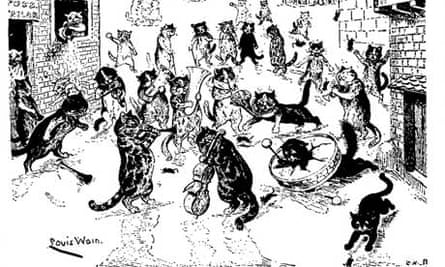He made the cat his own. He invented a cat style, a cat society, a whole cat world. British cats that do not look and live like Louis Wain cats are ashamed of themselves.
This was H. G. Wells's tribute 35 years ago to Louis Wain, the centenary of whose birth falls today. Wells was supporting a broadcast appeal by Robert Loraine for Louis Wain, who had been taken as a pauper to a mental home. Ramsay MacDonald was another of the many famous men and women horrified to learn that one of the most popular artists in the world for more than 30 years had fallen on such evil times that he lacked even paper and pencil to use during his lucid moments.
"Louis Wain was on all our walls some 15 to 20 years ago," Ramsay MacDonald wrote in 1925. "Probably no artist has given a greater number of young people pleasure than he has."
Louis Wain died only in 1939, a few days before his eightieth birthday, but circumstances and mental illness had virtually ended his curious career 25 years earlier. Several generations have now grown up to whom his name means nothing. But for millions over 50, his name, or the sight of one of his characteristic cat drawings, revives childhood memories, as they did for Ramsay MacDonald.
For more than 30 years there were few nurseries without Louis Wain cats smiling down from the walls. Louis Wain books and annuals in the toy cupboard and Louis Wain postcards in an album. The cats he sketched and painted - at the rate of 1500 a year - were reproduced by the million in Britain and America. His publications fill three columns of the British Museum catalogue. Christmas 1903 alone was marked by the publication of 13 Louis Wain books and many drawings for Christmas numbers. But in their very nature these publications were ephemeral and collectors today appear ready to pay 10 or 20 times the published price for them. His later pictures made in a mental hospital have been collected for a different reason. He continued to draw and paint to the end, and as the familiar friendly cats changed into increasingly elaborate patterns with the progress of his illness they provide classic examples of schizophrenic art.
Louis Wain's private schooling was fragmentary and a decision at 17 to become a musician was changed after six months' study because he decided art offered an easier path to the fame and fortune he desired. He studied for three years at a small London art school and stayed as a master. He was attracted to the then bohemian world of Fleet Street and tried to sell sketches to magazines. He sold his first - a drawing of bullfinches - soon after his twenty-first birthday. He failed to sell the next 30 pictures he offered this editor, but he slowly established himself as a press artist specialising in birds and animals. but never in cats.

At the age of 23 he married, and it was a black-and-white kitten given as a wedding present that almost accidentally transformed his life and won him world fame. Soon after marriage his wife was struck down by a lingering and fatal illness. Peter, the black-and-white cat, would sit on her bed, and during his long sickroom vigils Louis Wain sketched and caricatured Peter to amuse his wife. She urged him to show these cat pictures to editors, but Wain, then reporting dog and agricultural shows, took himself seriously as an artist. The remark of an editor, "Whoever would want to see a picture of a cat?" led to the pictures being put away until 1886, when Sir William Ingram, editor of the "Illustrated London News," realising the originality of some Louis Wain cats he saw, suggested a picture of a cats' Christmas party across two pages in the Christmas number.
In a few days, drawing on his notebook of sketches of Peter, Wain produced a picture containing about 150 cats, each with its own expression, each doing something different. The picture made an immediate hit. Comments and requests for copies came from all over the world. Louis Wain found himself famous almost overnight.
This is an edited extract, click here to read the full article

Comments (…)
Sign in or create your Guardian account to join the discussion